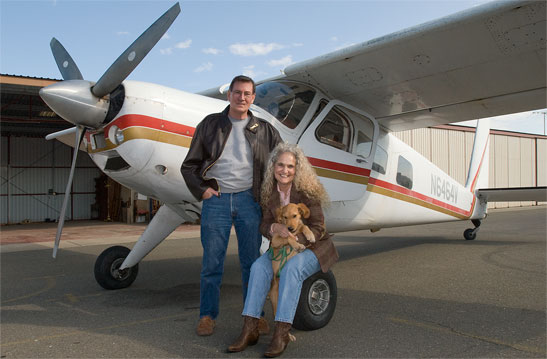Robert Campbell
Robert Campbell’s license plate reads "DC3 CAPN." His
wife Jennifer’s car displays "DC3 CREW." They met in
1995 flying tourists over San Francisco Bay in a restored 1938 Douglas
DC-3 airliner owned by Otis Spunkmeyer, Inc., (The Cookie Company).
Campbell was a Captain; Jennifer a Stewardess. Yes, Stewardess! Gender-neutral
terms such as flight attendant were decades away from the 1930s and
40s aviation era recreated by the Spunkmeyer flights. It was in that same 1930s era that Campbell’s father, Douglas, an avid amateur photographer and filmmaker, piloted an airplane he had purchased from his friend, Charles Lindbergh. Stories of his father’s experiences fascinated Robert as a youngster growing up in San Francisco in the 1950s, sparking a lifelong passion for both flying and photography. A Piper Cub pilot gave Campbell his first taste of small plane adventure at age twelve. Young Robert rode along as the tiny two-seat aircraft landed and took off from levee roads in California’s Sacramento Valley, patrolling hunt club property for poachers. Campbell’s most vivid memory of that first flight was watching a V-formation of flying geese overtake and pass the slow moving Piper! Following high school years devoted to art, photography and skiing, (not necessarily in that order), Campbell enrolled at the University of Oregon, but dropped out after his freshman year to learn how to fly. In little more than a year, he earned his Commercial, Multi-engine and Instrument Pilot Certificates and began flying charter flights for an air taxi company in Oakland. In 1967, he began studying photography at San Francisco State College with Don Worth and Jack Wellpott. A Yosemite summer workshop with Ansel Adams in 1968 led to an introduction by Ansel to Bill Garnett, the noted aerial photographer, who inspired Campbell to explore patterns from the air with his Hasselblad and Leica cameras. Campbell continued photographic studies at SF State for the next two years, concentrating on color photography and printing with Don Worth. However, unlike the plant close-ups and other terrestrial-based images of his mentor, all of Campbell’s photographs were aerials, including many abstract compositions of the multicolored Cargill Salt Ponds at the south end of San Francisco Bay. In the 1970s, the air freight industry entered a period of rapid growth, and Campbell left college to pursue a full-time career as a "freight dog." Aviation pundits like to joke, "You might be a freight dog if your airplane was getting old when you were born, and you haven’t made a daylight landing in the past six months." Robert certainly met those qualifications. He flew DC-3s and Beech 18s that first rolled off the assembly line in the late 1930s and early 1940s, and he flew them almost exclusively at night in all kinds of weather carrying cargo that ranged from lab rats to Marie Osmond’s hats! Nine years of night flying wore out Campbell’s enthusiasm for the air freight business, so he returned to photography with a job at San Francisco’s largest commercial color lab. A year later, he started his own lab and aerial photography business. Now based in Forestville, California, Robert Campbell Photography serves the aerial still photography needs of clients ranging from aviation companies, shipping lines and the Public Broadcasting Corporation to the National Park Service, the US Army Corps of Engineers and numerous other public and private companies. |
|---|
Intro | Robert
Campbell | San Francisco | Oakland | Marin
County | Point Reyes | Sonoma
County
California Coast | California |
GGNRA | Other
Places | Salt Ponds | Digital
Salt Ponds | Clouds |
The Bridge
Maritime | Aviation | New
York City | The American Dream
Phone: 707 820 1464

